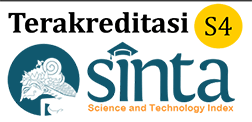Deteksi Dini Masalah dalam Proses Belajar Mengajar Secara Daring Menggunakan Sistem AT-OLP
DOI:
https://doi.org/10.32815/jitika.v15i2.485Kata Kunci:
Pembelajaran daring, e-learning, system AT-OTPAbstrak
The pandemic period covid-19 pandemic period forced many sectors in various fields to do work from home, as well as in education. Various schools ranging from elementary to tertiary level, are asked to carry out the teaching and learning process from home online or what is commonly referred to as online learning. The use of e-learning does help in the implementation of online learning, thus making students learn independently and motivation increases but there are difficulties that occur in controlling the implementation of online learning so that students are not supervised effectively. The research method used in this study is the FAST method because the framework is flexible enough for various types of projects and strategies. To control, the AT-OTP system is used is a system used to monitor the teaching and learning process activities online, using the concept of openness to all activities carried out. So that with the open mutual, the problems faced can be immediately known and sought solutions to these problems.
Keywords: Online learning, e-learning, AT-OTP system
Unduhan
Referensi
[2] D. I. K. Subang, “Efektivitas Implementasi Pembelajaran Daring (FULL Online) Dimasa Pandemi COVID-19 pada Jenjang Sekolah Dasar Di Kabupaten Subang,” J. Ilm. PGSD STKIP Subang, vol. VI, no. 01, pp. 1–9, 2020.
[3] R. Pakpahan and Y. Fitriani, “p-ISSN : 2598-8700 ( Printed ) ANALISA PEMANFAATAN TEKNOLOGI INFORMASI DALAM PEMBELAJARAN JARAK JAUH DI TENGAH PANDEMI VIRUS CORONA COVID-19 JISAMAR ( Journal of Information System , Applied , Management , Accounting and Researh ) p-ISSN : 2598-8700 ( Pri,” J. Inf. Syst. Applied, Manag. Account. Res., vol. 4, no. 2, pp. 30–36, 2020.
[4] S. Mariko, “PERANCANGAN PORTAL E-LEARNING MENGGUNAKAN DRUPAL CMS SEBAGAI PENUNJANG PERKULIAHAN PADA MASA PANDEMI COVID-19,” Ilm. Educ., vol. 6, no. 2, 2020.
[5] Y. Pujilestari, “Dampak Positif Pembelajaran Online Dalam Sistem Pendidikan Indonesia Pasca Pandemi Covid-19,” Adalah Bul. Huk. dan Keadilan, vol. 4, no. 1, pp. 49–56, 2020.
[6] Y. P. Utami, D. Alan, D. Cahyono, and U. T. Indonesia, “STUDY AT HOME : ANALISIS KESULITAN BELAJAR,” J. Ilm. Mat. Realis., vol. 1, no. 1, pp. 20–26, 2020.
[7] A. Sadikin et al., “Pembelajaran Daring di Tengah Wabah Covid-19 ( Online Learning in the Middle of the Covid-19 Pandemic ),” J. Ilm. Pendidik. Biol., vol. 6, no. 1, pp. 214–224, 2020.
[8] B. Setiaji, P. Ariadi, and C. Dinata, “Analisis kesiapan mahasiswa jurusan pendidikan fisika menggunakan e-learning dalam situasi pandemi Covid-19 Analysis of e-learning readiness on physics education students during Covid-19 pandemic,” J. Inov. Pendidik. IPA, vol. 6, no. 1, pp. 59–70, 2020.
[9] F. S. Didin, I. Mardiono, and H. D. Yanuarso, “Analisis Beban Kerja Mental Mahasiswa saat Perkuliahan Online Synchronous dan Asynchronous Menggunakan Metode Rating Scale Mental Effort,” J. OPSI, vol. 13, no. 1, pp. 49–55, 2020.
[10] Brooke, J. (2013). SUS: A Retrospective. Journal of Usability Studies, 29-40.
File Tambahan
Diterbitkan
Cara Mengutip
Terbitan
Bagian
Lisensi
Setelah diterima untuk publikasi, penulis mengalihkan hak cipta artikel mereka kepada Jurnal Ilmiah Teknologi Informasi Asia. Ini mencakup hak untuk mereproduksi, mentransmisikan, dan menerjemahkan materi dalam bentuk atau medium apa pun.
Sementara dewan redaksi berusaha memastikan keakuratan, mereka tidak bertanggung jawab atas isi artikel atau iklan. Tanggung jawab sepenuhnya berada pada penulis dan pengiklan masing-masing.
Materi di situs web dilisensikan di bawah Creative Commons Attribution 4.0 International License (CC BY 4.0). Di bawah lisensi ini, pengguna bebas untuk berbagi dan menyesuaikan materi untuk tujuan apa pun, termasuk penggunaan komersial, asalkan persyaratan lisensi terpenuhi. Kebebasan ini tidak dapat dicabut oleh pemberi lisensi dalam kondisi tersebut.















